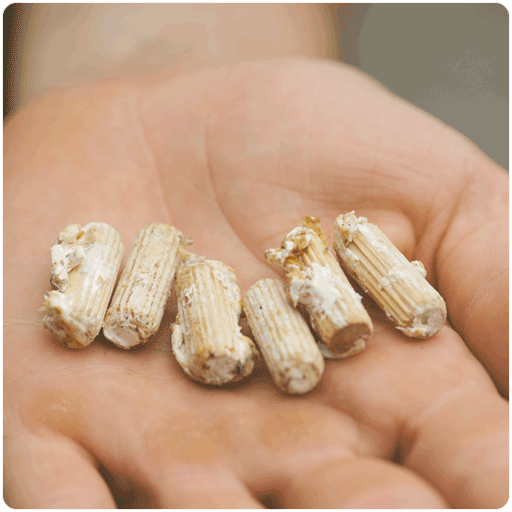Our mushroom plugs are filled with high-grade, contaminant-free mycelium that we make in a sterile environment
Whether you refer to them as mushroom plugs, plug spawn, or mushroom cultivate plugs, one thing is for certain: We can provide you with the highest-grade product for growing an assortment of mushrooms. Mushroom plugs consist of mycelium grown out on birch furniture dowels. The dowels are typically 5/16 inches in diameter and 1 inch long. They are usually a little bit more expensive than sawdust spawn and take about 30% longer to colonize. Plug spawn is a good option for growers who are inoculating 20 or less logs each year. Our Fungi Ally mushroom plug spawn is available for a variety of mushrooms, including Shiitake LE46, Blue Oyster 3015, Yellow Oyster AM1, maitake, and lion’s mane mushrooms. If you already know you want to buy some of our mushroom plugs, then proceed to this page and pick which varieties of mushroom plugs you want! You can order in quantities of 100, 1,000, or 2,000, so be sure to try a couple strains. Do you need more information on using mushroom plugs to grow your own tasty mushrooms at home? Well you’ve come to the right place! Continue on through this article to learn more about growing edible and medicinal mushrooms with mushroom cultivation plugs. The first step to mushroom cultivation on logs is cutting and selecting logs to grow on. Logs are best cut between November and March. In trials done by Field and Forest logs that were cut in October and allowed to sit until April for inoculation had much faster spawn run than logs cut later in the winter. In some cases logs were fruiting in the same year as inoculation. It is okay to cut at any time of year but yields and colonization time are affected. A Cornell study showed yields were highest from logs cut in winter and inoculated in spring. Cornell did not look at cutting in the late fall and inoculating in the spring. The best results are achieved when logs are sourced in the fall when 30% of leaves have changed color. If logs have been sitting for 2+ months it is good to rehydrate them before inoculating by soaking them in water for 3-6 hours. The bark of the logs should be as intact as possible; avoid logs with large strips of bark removed. Dense hardwoods like oak, sugar maple, and beech are great species to use.How to grow delicious mushrooms with mushroom plugs
If you have wood logs or tree stumps around your yard, then plug spawn is a perfect option for growing your own mushrooms. Our mushroom plug spawn is made of 1” birch dowels, which we cover with mycelium. Spawn plugs are easy-to-use and don’t require any special equipment or tools. Spawn run may take a bit longer with this mushroom plugs over other types of growing medium, like grain spawn or sawdust spawn. But as mentioned above, if you have a lot of wood logs, downed trees or stumps to inoculate, then our plug spawn is the perfect option for your mushroom garden. To inoculate downed wood logs, drill holes about 1¼ inches deep with a bit length of 5/15”, and place a spawn plug into the hole. Evenly space holes for mushroom plugs throughout the entirety of the log. If you were to use logs that are on average 3½ feet log, you’d likely be able to fit 50 plugs into the log. Be sure to only use one plug per hole, and tap the plug into the log with a hammer or rubber mallet. Once you have each mushroom plug tapped in, you should cover the holes with either beeswax or cheese wax to insure that no other forms of fungi disrupt your plug.Get to growing your own tasty mushrooms at home - buy your mushroom plugs now
Now is a great time to start growing mushrooms with our plug spawn
Spring, summer and fall are appropriate times for getting your mushroom spawn into logs. It’s too late in the season to start the process once temperatures drop into freezing and consistently stay there for a month or so. But until then, it’s a green light for your growing pleasure.The best wood types for our mushroom plugs
It’s good to know which types of wood are best for the various mushroom strains we provide.- Shiitake LE 46 and Blue Oyster 3015 are best grown on hardwoods like alder, ash, beech, or oak.
- Yellow Oyster AM1 is softer hardwoods like poplar, aspen, and elm can be used for outdoor cultivation.
- Maitake is best grown on oak stumps that have contact with the ground.
- Lion’s Mane is grown well on totems and logs of beech trees.
Check out our selections of mushroom plug spawn and buy yours today!

